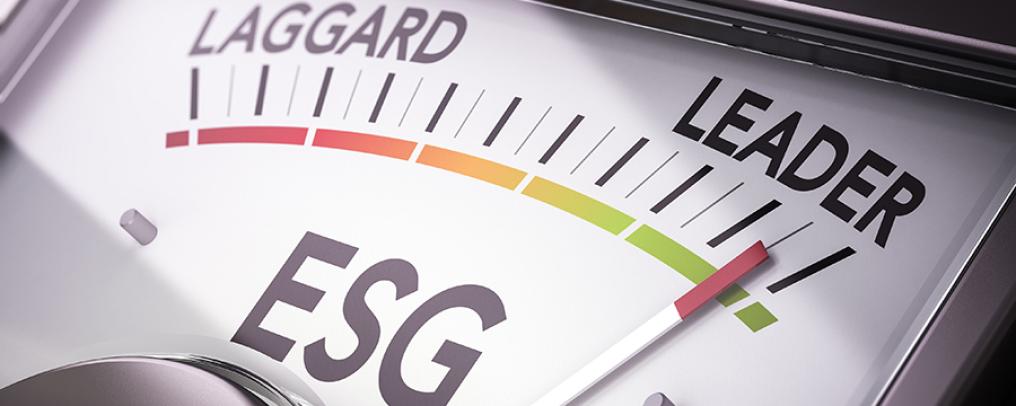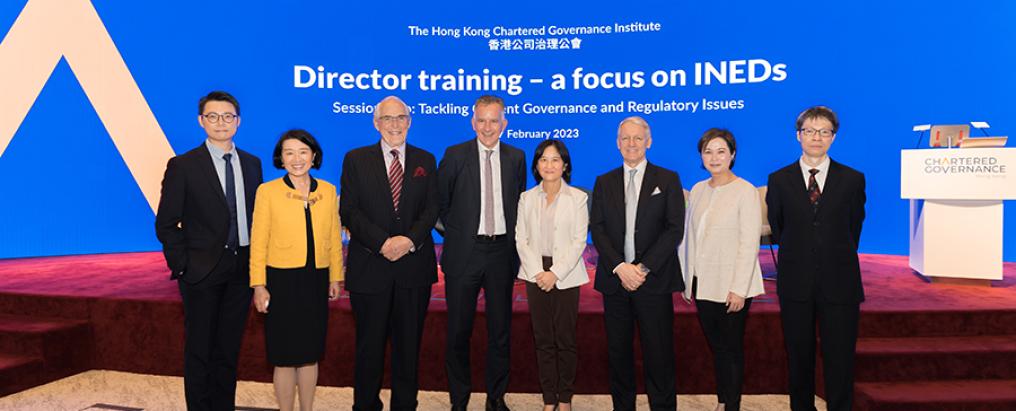
Director training – a focus on INEDs; Session 2, part 1 – the risks and rewards
The second session of the new director training series launched by the Institute, in collaboration with Hong Kong Exchanges and Clearing Ltd (HKEX), highlighted the risks and rewards of the independent non-executive director (INED) role.
As members of the board who are independent from the executive, INEDs are expected to constructively challenge management and provide an independent view on the issues considered by the board. Despite their necessary distance from the executive, they share the same duty of care and fiduciary duties, and the same liability in cases of fraud or malpractice, as executive directors.
The second session of the Institute’s new director training series (Director training – a focus on INEDs) offered participants a sobering perspective of the ‘natural hazards’ that INEDs are exposed to. In his presentation, David Gordon Eldon GBS CBE JP, Deputy Chairman, The Hongkong and Shanghai Banking Corporation Ltd, gave an entertaining, but highly effective, warning about the risk exposures INEDs should consider before they accept a board appointment. In particular, he focused on the ways that INEDs sometimes rely on false assumptions about the role they are taking on.
Five false assumptions to avoid
1. History never repeats itself
Mr Eldon started his presentation by quoting a description of climbing a frozen waterfall written a century ago by scientist and mountaineer Norman Collie. The description, he said, is a perfect summary of what it's like serving on a board as an INED and he went on to outline some of the ‘dangerous slippery slopes’ that would-be INEDs should be aware of. The first of which is the naïve assumption that massive corporate collapses, such as that of the energy company Enron in 2001, are a thing of the past.
Sadly, Mr Eldon pointed out, the Enron scenario – huge financial losses, criminal investigations, directors going to jail – is repeated on a regular basis. Indeed, within a year of Enron’s collapse, the demise of Worldcom took over at the top of the list of the largest bankruptcies in the US. Then in 2008, the fall of Lehman Brothers set a new record in terms of assets held prior to going bankrupt. Moreover, in the case of Lehman, significantly higher levels of blame were directed at the directors for their ineffective oversight and absence of financial expertise. ‘In the words of one former Lehman executive,’ Mr Eldon said, ‘the board was both a joke and a disgrace.’
Since Lehman, there have been a steady flow of corporate scandals – Boeing, Theranos, FTX and Evergrande among them – where the board has come under scrutiny for falling short of expected standards.
2. How hard can it really be?
A second slippery slope, Mr Eldon pointed out, is underestimating the difficulty of carrying out the INED role. ‘You just have to attend some meetings, collect your compensation, right? Wrong. Gone are the days when members of a board could sit back and claim they just didn't know what was going on,’ he said.
Going forward, boards collectively and directors individually are going to face increased shareholder scrutiny, as well as higher market expectations. In many jurisdictions, INEDs can also expect tougher consequences for their actions, or inaction, as the case may be.
‘The reality is that all directors, executive and non-executive alike, are going to face far more pressure as we go forward, to devote more time to meeting evolving regulatory demands, to monitoring and managing potential risks and to future-proofing their companies,’ he said.
He added that, in the era of social media, directors can also find themselves in the crosshairs of anyone with an axe to grind about an issue. Even when they are eventually proven incorrect, accusations published on social media can result in short-term damage to shareholder value and director reputations.
3. All boards are basically the same
Recognising good boards from bad, Mr Eldon stressed, is a skill INEDs need to develop. ‘You are lending your name and reputation to a company when you accept a directorship and, as we say in the world of banking, be always sure to lend wisely,’ he said.
He cited a number of factors that will help determine the quality of a board looking to appoint an INED – the first being board diversity. Good boards bring together a diverse group of individuals, he said, and diverse not only in terms of directors’ backgrounds and gender but also age.
‘I find it disappointing that decisions are being made by directors of a certain age that will impact the next generation when that generation has had no say in the decision. I'm not saying that you need to have a board that's filled with very young people, but at least listen to what the next generation has to say,’ he added.
Good boards also regularly seek input and expertise from outside parties and have a constructive dialogue with shareholders. ‘Bad boards tend to treat their shareholders as an annoyance that they have to put up with,’ he said.
The biggest red flag, however, is where a board is little more than a rubber stamp for management decisions. This point was taken up in the Q&A session at the end of the session (see ‘The importance of constructive challenge’). Mr Eldon shared an anecdote relating to joining a new board where, at the end of the first board meeting, the pre-printed minutes reflecting the just-completed discussions and decisions were passed around for approval immediately after the meeting adjourned. ‘I was only involved with this particular board for a very short time. I hope for obvious reasons,’ he said.
4. How time consuming can it really be?
Another slippery slope INEDs need to be aware of is the danger of thinking that they can serve on more boards than they actually have the time or energy to properly serve. He conceded that the question of how many directorships are too many is difficult to answer, and will largely depend on the capability and capacity of the particular individual involved, but he urged directors to be wary of overboarding.
This question also depends on the regulatory requirements of the company’s jurisdiction of incorporation, he added. In some jurisdictions – the UK for example – not all board seats are treated equally when calculating whether an individual is overboarded or not. A non-executive seat counts as one board mandate, but if you're serving as a non-executive chair of a board that counts as two mandates. No consideration is given to how many board committees you sit on, however, despite the fact that participating in board committee meetings will clearly increase the time commitment involved. ‘As others have noted, there are considerable shades of grey in all of this, but the point is don't spread yourself too thin,’ he added.
5. There is safety in numbers
For his fifth false assumption INEDs should avoid, Mr Eldon left behind the ‘dangerous slippery slopes’ to use an analogy from another, even more dangerous, extreme sport – underwater cave diving.
Cave diving is considered to be one of the world's most hazardous activities – can it really be compared to the level of risk that INEDs are exposed to? ‘This last bit of advice is without a doubt, the most important learning that I can share with you based on my own experiences around boardroom tables,’ Mr Eldon said.
The underwater cave diving metaphor has several lessons for potential INEDs, he explained. As in cave diving, there will be times when you lack visibility of a company's various goings on, and you also cannot rely on the approach and skills you may have acquired as an executive director on a company board. Cave diving requires entirely different skills from open-water diving.
Most important of all, however, while cave divers sometimes dive together, when they do so they still dive solo. ‘If you depend on a buddy in a cave, you will end up with a double drowning, because each person is falsely relying on the other,’ Mr Eldon said.
Similarly, INEDs should not have a false sense of security and trust because they are surrounded by other directors. The reality is that they need to rely on their own abilities, their own critical thinking, their own ability to speak up and ask tough questions. ‘If you remember only one piece of my advice today, remember that as an INED you are diving solo. Even when sitting around a boardroom table with other directors, you are still diving solo, just together.’
In conclusion – companies need you
Mr Eldon concluded his presentation by adding that, despite the dangers alluded to above, there is so much to be gained from taking on an INED role. ‘Companies need you and I wish you all the best of luck when it comes to navigating the natural hazards of serving as an INED,’ he concluded.
The first session of the training series reviewed in this article was reviewed in the March edition of this journal. More information is available on the Institute’s website: www.hkcgi.org.hk. Look out for the CGj review of the third and final session in this series in a future edition.
SIDEBAR: The importance of constructive challenge
The second session of the Institute’s new director training series generated a lively discussion on the dangers of joining a board that is little more than a rubber stamp for executive decisions. In the Q&A at the end of the session, speakers and panellists agreed that the approach taken by the board chair is key in setting the right culture of constructive challenge at board meetings.
Panellist John Williamson, Independent Non-Executive Director, London Metal Exchange and Pacific Basin Shipping Ltd, and Chairman, UK Tote Group, emphasised that the approach taken by the board chair to how meetings are conducted is the single most influential factor in creating an open and transparent board culture. ‘For me, it typically stops with the chair. If you have a chair who is sufficiently knowledgeable, experienced and respected, you’re halfway there already,’ he said.
There are, of course, other factors and Mr Williamson highlighted the importance of the relationship the directors have with management. ‘If you don’t have a management team that is properly engaged with the board and ensuring the requisite level of transparency, it’s very difficult for the board to be effective in any shape or form. I also think it’s important to get the balance right between the responsibilities of the board and what’s delegated to management.’
In addition, there needs to be a willingness among the directors themselves to speak up and ask hard questions. ‘Directors need to be prepared, for want of a better expression, to occasionally stick their heads above the parapet,’ Mr Williamson said. They also need to be able to listen to the sometimes divergent views of their colleagues on the board – putting their egos to one side to work collectively for the betterment of the company.
Another panellist, Frank Yuen FCG HKFCG, Group General Counsel and Head of Compliance, CK Hutchison Holdings Ltd, emphasised that asking even the basic questions can result in huge value to the organisation. The fact that managers know that questions will be asked at the board level about business decisions and corporate transactions means that they will be held accountable for the decisions they make.
‘When board members, in particular the outside directors, ask questions and press for an answer, they help to shape the culture because management knows that they can’t escape from their responsibilities in their day-to-day management decisions,’ he said.


